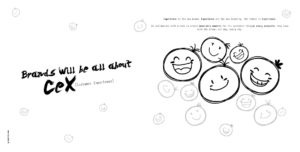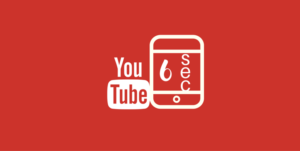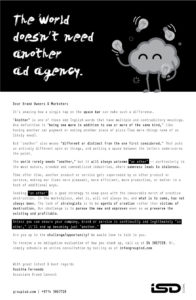“The best way to find your self is to lose your self in the service of others”- Mahatma Gandhi.

Distilled, actionable insights on branding, innovation, creativity, leadership, soul enhancement, marketing, advertising and design thinking
“The best way to find your self is to lose your self in the service of others”- Mahatma Gandhi.

1. A social condition that affects a society because of the elevated number of individuals striving to be wealthy. People within the society feel that the only measure of success is determined by how much money and prestige a person has.
2. A social theory claiming that individuals with very privileged and wealthy backgrounds sometimes struggle to determine the difference between right and wrong due to the nature of their upbringing. Also known as sudden-wealth syndrome.
Having done that, Stuffocation is defined by Macmillan’s Crowdsourced Open Dictionary as:
– a feeling of being oppressed by the amount of stuff you own. The problem in question is an anxiety christened stuffocation – a feeling of being oppressed by one’s ungovernable heap of belongings, acquisitions.

We have galloped on from an industrial economy to that of knowledge and intelligence(artificial & otherwise). Getting ahead is an industrial age concept. Based on scarcity, lack of access, secrecy, connections etc.Everyone can’t be first (the thinking goes) so you better work harder, make do with helping fewer people, and look for shortcuts if you want to win.

Today, we live in an always on,connection, collaboration sharing economy, in a long-tail world where being remarkable is far more important than being normal, where mattering is what matters and what we ideally seek. But the void is still there. It’s a gap between where you are and where you could be. Where you desire to be. A gap between the impact you can create and what you’ve been able to do. Mostly, it’s a gap between you and the change you can contribute to those around you. As they say, what got you here, won’t get you there.
To propel from your present state, to being a ruckusmaker, a toastmaster, a change agent, a denter, a doer, an enabler. A person who notices, who seeks change and, above all, a person that leaps. Takes the power in her hands, to assist the powerless, the privilege dark community. (Read how 3 designers from Ideo.org are trying to fix the refugee crisis in this BrandKnew article here http://www.brandknewmag.com/from-ideo-org-3-ways-designers-can-help-fix-the-refugee-crisis/ )
To have the spirit to care for the have not. Lets walk the torque. Devoid of the void!
ENDS
Image: Plays In Business
www.groupisd.com
www.brandknewmag.com
The death of an advertising stalwart!
Well it surely appears so. And Silicon Valley is killing it.The rise of social media has made the elaborate plot lines of old-school spots seem archaic. And the Mad Men are, well, mad.Or, so was the fad!
Trapeze back to the days of the 30 second long format ads(long by today’s standards) where marketers, brand owners, agency heads, creative directors, art directors and film makers peddled a basketful of promise, creative thought and motivation to influence the seemingly reachable TG in their quest to change behaviours, cultures and consumption patterns. There was a certain trance in that romance to create.

So what is prompting the change? In an always on land of uncertainty, are we losing the plot(and losing the audience) or has the landscape itself changed?
6 is the new 30
They say 20 is the new 40 when it comes to audience maturity and demographics. Platforms like YouTube have increasingly challenged agencies to tell their stories in a 6-second slot — the average attention span of today’s mobile user. That mobile user, who again by conventional paradigm, is on a perennial instant fatigue. So 30 seconds is a long journey to risk with them! 6 has indeed become the new 30. And numbers don’t lie!
It makes sense. You might be willing to sit through a 3-minute trailer before a movie, or a 30-second “Whassup” ad before an episode of Jimmy Fallon.That may come across as non intrusive or no skin of your back. But amidst the native content of notoriously short-form channels like Instagram or Snapchat, these types of ads are disproportionately long. So much so, that they may pre qualify to be spam! Just kidding.
And for all those who are number crunchers: if we had a nickel for every 60-second YouTube video we gave up on because of an unskippable 30-second ad, we’d be at least $1.25 richer. What will you do for a few dollars more?
“Creativity is dead.” — Old School Advertisers
That almost seems like an Old Jungle saying(remember Phantom is rough with roughnecks!!!).
Ad execs counter that cutting time means sacrificing emotional stakes and story arc for the sake of speed, effectively prioritizing watchability over effectiveness.
Another, not-so-secret motive: it’s harder to get paid proportionally for the production of super-short ads, which still require actors and equipment.The CFO and CMO lines have been blurring and the motive should not surprise us.
Hey, we love Ogilvy as much as the next ad geek. But as the father of mass media, Marshall McLuhan, put it back in the ‘60s: “The medium is the message.” Yes, we now surely get the message.
And today’s medium is 6-second Snap Stories. And it has to be over in a snap. Otherwise today’s audience will snap out of it.So the mean median for a message is all coming down to 6 in the City(and beyond).
So, Lights, Camera….do we have the time to say Action?
ENDS
www.groupisd.com
www.brandknewmag.com
Image: Digitalvidya
So, the next time you are developing or enhancing a product,it would be worthwhile to look beyond the ‘ walled garden ‘ that defines/chains your industry for some analogous inspiration. For that idea or product of yours to become truly beyond compare.
If one were to go granular with the emotions’ basket, we would have the following and more in the bucket list:Happiness/Joy; Sadness/Depression; Rage/Anger; Pride/Prejudice; Disgust/Disillusionment; Wonder/Awe and so on and so forth.
Researchers at the Beihang University in China gauged various online emotions by tracking emoticons embedded in millions of messages posted on Sina Weibo, a popular Twitter-like microblogging platform. Their conclusion: Joy moves faster than sadness or disgust, but nothing is speedier than rage. The researchers found that users reacted most angrily—and quickly—to reports concerning “social problems and diplomatic issues”. It’s diabolical that a strong anti social emotion like rage gets the maximum social attention and currency!!!
In many cases, these ‘ social flare ups ‘ triggers a chain reaction of anger with multiple circles of the social community getting influenced and participating with equal or more venom.
In another study conducted by Jonah Berger and a colleague at Wharton based on 7000 articles covered by The New York Times, they discovered that if there was one emotion that overtook rage in billings, it was awe. The wonder and excitement of a new discovery of beauty or knowledge or a breakthrough in the fight against cancer; puts awe as an emotion in overdrive thus heaping bagfuls of viral.“Awe gets our hearts racing and our blood pumping,” Berger says. “This increases our desire for emotional connection and drives us to share.”
For all those who thought that sadness would emerge triumphant in the race to viral stardom, sorry to disappoint you. Sadness was considered to be a ‘ deactivating emotion ‘ where people pull down or withdraw leaving it with little torque to go the distance. If you feel a little melancholic about it, let that stay.
So, the next time you see or experience road rage, talk yourself into believing that it need not be infectious(or go viral).
ENDS
groupisd.com
brandknewmag.com


www.brandknewmag.com
www.groupisd.com
If you are brand building, then reach for the EMOTE CONTROL!
A trend that is often overlooked in marketing is that everyones feels before they think and that the non rational emotional reaction comes before the more rational secondary one. One way to minimise branding risk is by looking into account what brain science tells us about the importance of creating an emotional connection with consumers.
Rene Descartes famously philosophised that ‘ I think, therefore I am ‘. Brands and businesses have religiously followed suit with a prejudice for the rational. In branding terms, this means that companies remain too product-focused, concentrating on functional, utilitarian benefits, which can be easily measured, monitored and understood. This is obstacle number 1. Continue reading “If you are brand building, then reach for the EMOTE CONTROL!”
It Takes Two to Tango
When, its the crack of dawn and you wake up with a cracker of an idea…
When, heavy metal(not the music variety) takes centre stage, as a billion go after the bullion…and its Dhanteras…
When, its the time to visit ageing parents (and friends on anti ageing creams as well)…
When, Bhaiyya will go really Dhoor to meet his Behna as its Bhaiyaa Dhooj... Continue reading “Happy Diwali: Two Words That Resound, Resonate,Reverberate!”
A meeting at Oracle HQ started a series of multi-billion dollar events. Now it’s come full circle.
Day before yesterday, tech behemoth Oracle agreed to buy fellow cloud software company, Netsuite, for $9.3B, the company’s largest acquisition since it acquired PeopleSoft in 2004.
But this isn’t your typical takeover. Silicon Valley, despite its global reach and constant innovation, still remains a tiny place full of friendships, family, and rivalries.
A meeting was held at Oracle HQ in Oakland, California between the company’s CEO, Larry Ellison and 3 key employees: Evan Goldberg, Zach Nelson, and Marc Benioff.
During that meeting, Goldberg, a developer, came up with the idea of software as a service (SaaS), painting Ellison a picture of building an internet version of Siebel, the biggest CRM software maker at the time.
Ellison liked the idea but told Goldberg he’d first need to build finance software, then build the customer software around it. So that’s exactly what Goldberg did and Ellison personally funded it.
Anyone care to guess what the company was called? Yep, Netsuite.
That means Larry Ellison just bought a company he helped launch and, more importantly, a business where he’s a 40% stakeholder. Carry the 2… that means he just netted $3.5B in cash.
They play a role in this, too — Zach Nelson is the current CEO of Netsuite, a position he’s held since 2002.
And as for Marc Benioff… let’s just say he left that meeting with a few ideas of his own. As Nelson tells it, “Benioff called back two weeks later and said ‘I’m going to do that Siebel online thing,’ and that became Salesforce.com.”
Salesforce and Oracle began competing for business shortly after that and the companies remain rivals to this day. In fact, Ellison is dead set on making $10B in revenue from cloud computing before Salesforce does.
Pretty much, yeah. The move makes plain business sense.
In order to continue growing its cloud market, Oracle had to start playing in Netsuite’s world, selling to small and midsize companies. And, prior to yesterday, there were two possible ways to play the game: Oracle snuffs out the little guy or the little guy defends its turf.
Larry the Cloud Guy decided to go rogue and whipped out the checkbook to create outcome #3: buy the little guy and win the whole f’n thing.
ENDS
Source Credit: The Hustle
www.groupisd.com
www.brandknewmag.com